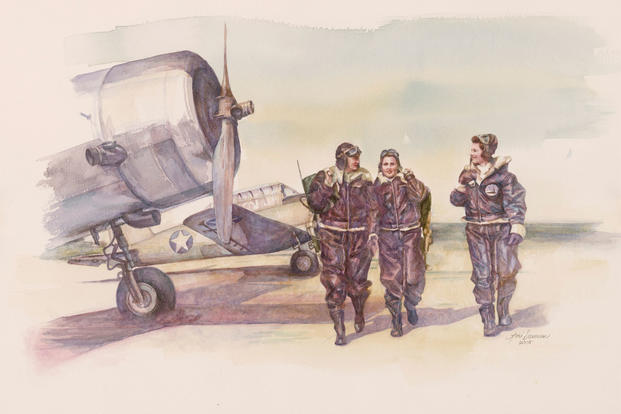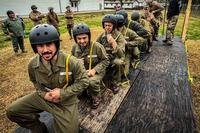The skies have inspired art from the beginning of time. Man's flight into the sky has the same effect.
Much of the best art inspired by the work of Air Force members is regularly donated to the U.S. Air Force Art Program. "The U.S.A.F. Art program began in 1950 with the transfer from [the] U.S. Army Air Corps of some 800 works of art, documenting the early days of military aviation in the U.S.," said Bob Arnold, the program's director.
The collection, now at 8,600 pieces, is a valuable historical record of military aviation in the 20th century. The works are on display in the Pentagon, on Air Force bases around the world and in private museums like Guild Hall of East Hampton, N.Y., the Science Spectrum in Lubbock, Texas, and the Southern Museum of Flight in Birmingham, Alabama.
More Than History
Documenting history with art has proven to be more than a simple inventory of objects, actions and events. The individual creative vision of the artists inspires the very people who inspired its creation.
"Among the most popular works are those that feature children, dogs and NASCAR," Arnold said. Air Force Gen. Curtis LeMay began a program to have portraits painted of senior officers. These, along with portraits of well-known airmen such as the Tuskegee Airmen, are among those that elicit the greatest response from the public.
"We have one painting that shows a cadet in the academy chapel. We regularly receive notes from people who think that their son is the youngster in the portrait. From youngsters to vets, we get notes that tell us that the art links them to their time in the service," Arnold said.
Said Russell Kirk, the program's assistant director: "Our World War II art also receives a lot of comments."
Developing the Collection
Over the years, the Air Force has built the collection through an acquisition process that works with professional art societies. Since 1952, the Air Force has sponsored special trips to installations for members of groups such as the New York Society of Illustrators.
The trips offer the artists a chance to obtain the up-close-and-personal contact with the inspiration for their sketches, paintings and watercolors. These societies also then "jury," or select, works to be donated to the Air Force. Donations occur every few years, with the next coming up in 2002. There are about 125 artists active with the program at any given time.
"If someone we do not know wants to donate, we have them send samples," Kirk said. "If their work is of good quality, we point them to one of the societies so that they can be juried by their peers."
Working with professional societies ensures that the level of art remains high. A frequent program contributor is Keith Ferris, whose two 75-foot-wide, 20-foot-high murals greet visitors to the Smithsonian's National Air and Space Museum in Washington, D.C. Over the years, he has contributed many oil paintings.
"I was an aeronautical engineering student at Texas A&M, and then I worked as a civil service apprentice artist with Air Force training publications at Randolph AFB," Ferris said.
That experience made him serious about art. Ferris continued his formal education at George Washington University and the Corcoran School of the Arts & Design in Washington, D.C. One of his paintings, Linebacker in the Buff, given in 1996, was based on the artists' own 1968 combat mission to North Vietnam's Mu Gia Pass in a B-52D 094.
Ferris has contributed more than 50 paintings. He is also honorary chairman of the Society of Illustrators in New York. His Smithsonian murals were dedicated in the July 1976 bicentennial opening of the Air and Space Museum.
Love of Flight
Each artist's vision is unique, but what is common to all is their love of flight.
"Many of the artists are concerned with detail right down to the mission number, who flew and the time of day," Arnold said. "They research the information and even the tail number of the aircraft."
William S. Phillips, a California artist, has contributed more than two dozen works.
"My desire to paint aviation subjects is deeply rooted in my childhood," Phillips said. "I have had a love affair with flight for as long as I can remember. My first attempts at depicting aircraft in an artistic way came when I was 12."
Phillips and a friend often watched flights at Van Nuys airport. He served in the Air Force in Vietnam and spent many afternoons sketching various aircraft on the bases where he was stationed.
"I first began to sell my work while in the Air Force," he said. "I began my professional career handling my work in the restaurant of a local airport. Later, I did some western and wildlife painting. But my big break came in 1975 when I was accepted into the Air Force art program. Aviation is my first love even today. A great deal of my art income is from aviation.
"Some of the experiences [of] being part of the program are truly exciting. I flew in with the Air Force to Mount St. Helen's shortly after the eruption to cover rescue operations, and I have flown in a vast variety of aircraft such as the F-15, F-106, RF-4, F-4E, OV-1 and T-33. Forty-two paintings were accepted.
"Just as the old masters lived their art, an aviation artist must fly to convey the true feel of his/her work," Phillips said. "I try to fly as much as I can."
The latest of Phillips' contributions is entitled Nowhere to Hide and was created after he accompanied a special air-to-air training mission with the 4th Fighter Wing at Seymour Johnson Air Force Base in North Carolina.
Future of the Collection
The few works that are not on display are stored at the Pentagon or at Andrews AFB, Maryland.
Putting the collection on the web is the next step in broadening its display audience. But the website will be more than a gallery in cyberspace. It will also serve as a research tool. Because the works document the Air Force so well, they are also a source of information for historians and others who want to learn more about the Air Force.
"A lot of people come to us who are doing books and research, and these are the ones who would benefit most by the web -- and it will save our staff time. The website is under design, but we have at least two years of work to complete prior to working on the website," Arnold said.
Want to Know More About the Military?
Be sure to get the latest news about the U.S. military, as well as critical info about how to join and all the benefits of service. Subscribe to Military.com and receive customized updates delivered straight to your inbox.














